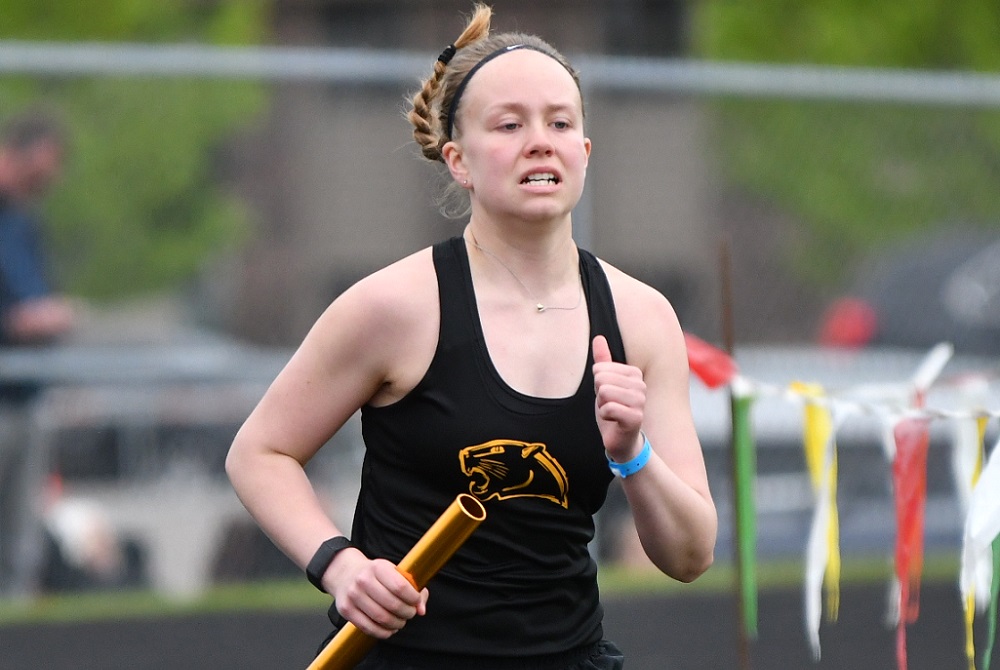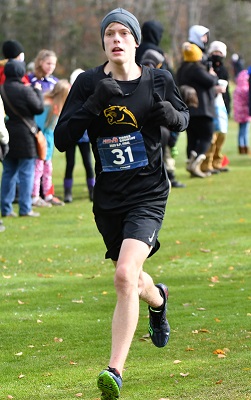
Ewen-Trout Creek Racers Fueled to Go Distance Again
By
John Vrancic
Special for MHSAA.com
May 25, 2021
BARAGA — Elise Besonen wasn’t always a huge fan of distance running.
 Then came 2020 and the COVID-19 pandemic, and the current Ewen-Trout Creek senior had a change of heart.
Then came 2020 and the COVID-19 pandemic, and the current Ewen-Trout Creek senior had a change of heart.
The University of Wisconsin-Superior basketball recruit now says she enjoys running.
Maybe there’s some truth to the saying “Absence makes the heart grow fonder.”
“I was pretty bummed when we didn’t get to run last year,” she said shortly after placing second in the 3,200-meter run at 13 minutes, 33.68 seconds in the Upper Peninsula Division 3 Regional meet last Wednesday at Baraga. “Then, I started running on some side roads with my dad, and it completely changed my mindset. It has been fun running for my dad. In my freshman year during driver’s ed, it was just us two. I guess it was sort of a blessing in disguise.”
Besonen was also runner-up in the 800 (2:40.21) and 1,600 (5:43.59) at the Regional, qualifying her for all three races at the Upper Peninsula Finals on June 5 at Kingsford.
“It was a pretty short meet,” said Besonen, who was also runner-up in the 800 at the previous Monday’s Copper Country Invitational in Houghton in a school-record 2:32.81. “The 800 and 3,200 were pretty close together, which made it pretty difficult because they were right on top of each other. At least my legs were warmed up.”
 Junior Jonah Nordine hadn’t run in nearly a week following a mishap during homecoming activities at the school two weeks ago.
Junior Jonah Nordine hadn’t run in nearly a week following a mishap during homecoming activities at the school two weeks ago.
“I fell off a bike and scraped up my knee and arm,” he said. “We usually have homecoming for basketball, but that got postponed due to COVID and (we) held it during baseball and track this year.”
Nordine, the reigning U.P. Division 3 cross country champion, won the 800, 1,600 and 3,200 in the Marcy Bracket Invitational at Bessemer on May 13, then was runner-up in the 800 (2:16.48) and 1,600 (4:40.27) and third in the 3,200 (11:28.33) at Baraga.
“I had a side ache in the 3,200,” he said. “I probably didn’t eat enough (that day). I was pretty happy with my times. I just wanted to qualify. We had perfect conditions at Bessemer. I didn’t run in Houghton, but it was quite warm. It was in the 80s. I’m just glad to be running this year after losing my freshman season to COVID.”
“Jonah’s success generates a lot of excitement for this team," added Ewen-Trout Creek track and cross country coach Brad Besonen, who also is Elise’s father. “Jonah’s personality changed after his success in cross country last fall. He has become more outgoing.”
Elise is best-known as a high-scoring guard who made the Division 4 all-state basketball team again this winter and was named Upper Peninsula Division 4 Player of the Year in the sport.
She figures to continue playing point guard for Wisconsin-Superior, another chase she’ll take on when her track season is done.
“There will be a lot of adjustments to make,” she said. “Everybody wants to be there, and I’m looking forward to that.”
 John Vrancic has covered high school sports in the Upper Peninsula since joining the Escanaba Daily Press staff in 1985. He is known most prominently across the peninsula for his extensive coverage of cross country and track & field that frequently appears in newspapers from the Wisconsin border to Lake Huron. He received the James Trethewey Award for Distinguished Service in 2015 from the Upper Peninsula Sportswriters and Sportscasters Association.
John Vrancic has covered high school sports in the Upper Peninsula since joining the Escanaba Daily Press staff in 1985. He is known most prominently across the peninsula for his extensive coverage of cross country and track & field that frequently appears in newspapers from the Wisconsin border to Lake Huron. He received the James Trethewey Award for Distinguished Service in 2015 from the Upper Peninsula Sportswriters and Sportscasters Association.
PHOTOS: (Top) Ewen-Trout Creek’s Elise Besonen completes her anchor leg of the 3,200 relay during the UP Division 3 Finals in 2019. (Middle) Jonah Nordine crosses the finish line first at last fall’s UPD3 Boys Cross Country Final. (Photos by Cara Kamps.)

Track Gaining Speed Toward Future with Electronic Starting Devices
By
Steve Vedder
Special for MHSAA.com
May 23, 2023
Aubrey Greenfield thinks it might be the perfect time to reevaluate 130 years of tradition.
For a number of reasons, from technical to personal, the Oxford senior sprinter believes it makes sense for the crack of a starting pistol to be eliminated from high school track meets.
Because track meets would benefit in various ways from lowering costs to easier setup at meets to the human factor of competitors not having to flinch at the crack of a pistol shot, Greenfield believes the sport has a chance to embrace new technology – electronic starting devices (ESD).
In essence, an ESD replaces the starting pistol with a light flash, tone sound or both to begin a race.
"High school sports should put the athlete first," Greenfield said. "We should promote sports, and eliminating starting pistols promotes health in terms of PTSD or trauma for athletes and spectators and that would be good. I would like to think people would say that's a good idea."
In fact, Greenfield would go as far as to say if there was not an implementation of electronic starting devices, many of her teammates would have considered giving up the sport.
"If it's something that helps us compete safely, we're all for it," she said.
Greenfield's opinion apparently is spreading. Michigan High School Athletic Association senior assistant director Cody Inglis said the use of ESD makes it both affordable for meet starters and sensible for athletes and fans to rethink the use of starting pistols. While the MHSAA is not mandating electronic starting devices, it does promote the use of what Inglis calls "emerging technology." He notes that ESD are becoming the norm for organizations such as USA Track & Field, the NCAA and an increasing number of high schools.
 "I think we have to embrace new technology, and we think this will be something that takes hold," Inglis said.
"I think we have to embrace new technology, and we think this will be something that takes hold," Inglis said.
A key part of embracing ESD is the human element. The tragic Oxford High School shooting Nov. 30, 2021, that took the lives of four students while injuring seven others should not be relived even for a fleeting instance at a high school sporting event. Oxford athletic director Tony DeMare said the school began using ESD at every meet, including the MHSAA Lower Peninsula Division 1 Finals last June. He said that decision was embraced by virtually all schools Oxford encountered.
"We were very convinced that the alternative (of ESD) would promote a healthy attitude," DeMare said. "We were overwhelmed with the positive response. If a school was on the fence about it or might not be for it, I think we've started to see the tide turn in favor of people willing to listen and learn about electronic starting devices."
Inglis said the MHSAA is acutely aware of what the crack of a starting pistol can mean to athletes and fans.
"It's unimaginable what Oxford went through, and this is a small way we can help," he said. "We look at a (starting pistol) and think, ‘Could we do something else?’ It's a way of helping to solve a problem."
Over the last several years, the MHSAA has embraced finding an alternative to starting pistols. Inglis noted the discussion started with the cost and diminishing availability of 32-caliber ammunition that meet starters use. A box of ammunition, if it can be found, is around $75 a box.
In addition to cost, there is potential damage from excessive exposure to 150-plus decibels of sound generated by the traditional 32-caliber blanks. Medical studies show damage to ears caused by decibel levels above 120 dB.
The tragedy at Oxford accelerated the conversation.
Inglis said the cost of ESD can be likened to a school sinking money into artificial surfaces at football fields. Yes, there is a great cost at first, but over time money is ultimately saved. An ESD system itself ranges between $200 and $500. Speakers also may need to be purchased, but with ESD starting events like the 800 and 1,600-meter relays positioned near the outside lanes 8, 7, 6 and 5 would result in improved hearing by athletes at the start of a race.
There is one challenge with ESD that track administrators are working to overcome – lighting conditions that lessen the ability to see the ESD’s LED light or strobe when the button is pressed by a starter to begin a race. But that vision difficulty resulting from clear blue skies and backgrounds of setting suns can be substantially improved by incorporating a black background with an ESD – something as simple as a starter holding up black cardboard behind the lighting mechanism at the start of an event.
Inglis said when all factors are considered, the use of ESD makes sense.
 "With the climate we live in nowadays, no lookalike guns is good," he said. "We're not mandating this. But people are saying this is affordable."
"With the climate we live in nowadays, no lookalike guns is good," he said. "We're not mandating this. But people are saying this is affordable."
While switching to ESD would break 130 years of tradition, the timing could be a step forward, said Jeff Hollobaugh, co-author of the book "The Fleet Feet of Spring: Michigan's High School State Championships in Track & Field." He said while no definitive answer is possible, it's likely starting pistols were used at the inaugural state meet at the Jackson Fairgounds in 1895. The meet, which included events like tossing a 16-pound shot put, bike races and a 100-meter sprint, was sponsored by the Michigan Interscholastic Athletic Association (a predecessor to the MHSAA) and comprised mostly of the state's larger schools.
Hollobaugh's sentiments echo what many involved in today's high school track & field believe in terms of making a transition from starting pistols to electronic starting devices.
"It's a change, not necessarily good or bad, just different," he said. "It's not a drastic change, but it will take some getting used to. But it is the future. In the end, we'll all be fine."
DeMare believes the future of high school track will definitely include ESD.
"Our desire is that the practicality and sensibility of this will overcome the alternative," he said. "I think we'll see the automation and electronics taking hold of certain elements in track, and people will embrace it."
PHOTOS (Top) Runners watch official Bertha Smiley as they prepare to begin a race during last season's Lower Peninsula Division 1 Finals at Rockford. (Middle) An electronic starting device provided by VS Athletics was used to start those races. (Below) Smiley sets to begin an event. (Photos provided by David Kuderka/VS Athletics.)

